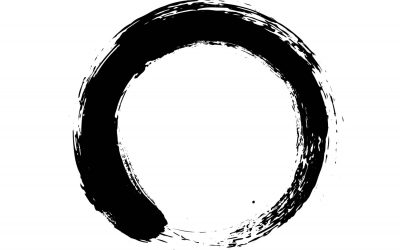Seeing, Breathing and Sexual relating.
In an informal chat, Roshi once named these as three of the most difficult activities for us human beings. That is the order that he used, I believe because it makes particular sense. Breathing is in the middle. Above, there is seeing and all the ‘heady’ or mental functions associated with vision. We can become obsessed with the extreme of seeing (distancing, comparing, measuring, analyzing, cool controlling).
Below is sexual relating with its associations of ‘primitive passions’, instincts, child bearing, biological continuity and so on. The extreme of sexual relating (uncontrollable emotions, fighting, loving, jealousy). Experiencing extremes in either one of these two activities makes for problems that can overwhelm everything else.
Not so with breathing. After in-breath an out-breath must follow; after out-breath, an in-breath must follow. The rhythmic or cyclic nature of breathing reminds us of existential affirmation and negation, appearance and disappearance and all the vital polarities of existence. Because of this central position, it is not accidental that attention to breathing is emphasized in zazen.
Incidentally, something can be learned from old Greek and Roman statues, and depictions of the human body in European art until a few decades ago. Unlike modern ideals which are top heavy in stressing broad shoulders and thin waists, in older art the mid-body is respected, not slighted. Male figures have the powerful abdomen of a wrestler, and the female figures have a glorious abdomen expressing potential motherhood. In our change-denying, mortality-hiding hangup with looking forever young and ‘on the go’, we tend to regard the normal mid-body of ourselves or others as aesthetically unpleasing or even as unhealthily overweight. If you think this is just a matter of preference, look at the normal bellies of small children before fashion-consciousness takes its toll.
Now how does this relate to breathing? In Victorian novels you can read about ladies fainting from the slight cause. No wonder! They wore tight corsets to pinch their waist. Then, to get even smaller waist, operations became fashionable in which lower ribs were removed. Dressed for social affairs, ladies were more or less in a constant state of breathlessness, not far from fainting. So the beginning instruction of zazen, to let your abdomen ‘protrude’ is not just an idiosyncratic aspect of Zen, it is simply acknowledging what is necessary for deep, relaxed breathing.
Roshi has said on other occasions “Raise your sternum (chest bone) and Breathe through your navel.” (This is referring to an even deeper breathing from your abdomen). The combination of the two makes maximum space for the lungs and fosters deep breathing. The diaphragm is the large transverse muscle between the lungs and the stomach cavity. When the sternum is up, and there is room for air in the abdomen bellow as well, the diaphragm can relax and move down, providing more place for the lungs to expand. Anxiety in general is associated with a high,tense diaphragm. Aside from Zen, the importance of breathing from the abdomen is well-known in the martial arts, in many other sports, in exercises preparing for childbirth, and opera singing. A manifestation of this is the sutra chanting of Roshi in his younger days which had a power and clarity that no one can come close to without breathing from the belly, sounding from the belly.
It is also taught that breathing should not be an in and out, or up and down affair, but to breath as if inflating a balloon, expanding 360 degrees, then deflating all the way around. Not often mentioned and seldom noticed in our everyday life, but strongly stressed in Tathagata Zen practice, are the two ‘resting’ points of breathing. When inhalation reaches its maximum expansion, there is a point of ‘rest’, where there is no movement. It is the same at the extreme contraction of the exhalation, a point of silent stillness is manifest. It is important in our practice to slow down and become more aware of these two ‘end’ points.
“With a powerful exhalation we give back, we fill the universe, exhaling all thoughts, no matter how attractive or unattractive.” That is another beginning instruction from Roshi. In the days before scuba equipment, divers who wanted to go deep, exhaled strongly to decrease their buoyancy. When first learning to practice zazen (meditation) we are told to breath out and settle into the cushions. A powerful exhalation at the outset brings you in touch with the center of your solar plexus. A biologist friend told me this ‘pit’ of the stomach is the oldest part of our bodies, the original father-impregnated mother-cell which exploded trillions of times to become one’s adult body.
Allowing that we can learn from the traditional wisdom residing in language, consider that our word ‘spirit’ derives from a Latin word ‘breath’. In a wide range of related words like ‘aspire’, ‘conspire’, ‘expire’, ‘inspire’, ‘perspire’, ‘respire’ the central importance of breathing is manifested. The equating of breathing with ‘mind’ and ‘life’ in general is evident in another family of words stemming from Latin, namely ‘anima’, ‘animosity’, ‘animate’, ‘animal’, ‘equanimity’, ‘magnanimous’, unanimous’. Consider how the ancient Greek word ‘phrenia’, referring to the diaphragm and breathing, was expanded to mean ‘mind’ in general as in our modern words ‘phrenology’ and ‘schizophrenia’. Or consider that the ancestor of ‘ghost’ is an Old English word meaning breath, spirit, or soul, thus dying or expiring was referred to as ‘giving up the ghost’.
Breathing is midway between voluntary and involuntary; between ‘spirit’ and ‘matter’; between human intention, human desire, and the non-intention, non-desire of Dharma functioning. Roshi has emphasized that we must discover how inhaling is also simultaneously exhaling. As we inhale the “outside environment” is breathing into us, at the out breath the “inside environment” is giving back. When we manifest this kind of breathing we come to realize that apparent “outside world” and apparent “inside world” are but ONE world doing the activity of “in and out.” Buddha Nature encompasses both objective and subjective, both father ( outside, future) and mother (inside, past). The air you breathe and the food you eat is ‘you’. What you breathed a while ago is reading these lines. Fully expressed, the whole universe is breathing with you, through you, as you. Once when diving, I came across a baby octopus. It was gently expanding and contracting in perfect rhythm, with its surroundings. First I had the impression that the ocean was moving the octopus, then, manifesting as octopus, I realized this little greenish-pink event as the lungs of the entire ocean.
We are usually unaware of breathing until exerting ourselves physically, until we are emotionally agitated, or ill. So, becoming aware of breathing in a calm state is important. Why doesn’t Roshi take it a step further and assign breath-counting or other methods of trying to control breathing? Years ago, while doing zazen in the backyard of a house, I heard a faucet slowly dripping. I tried to ‘become’ the dripping but noticed that my breathing got synchronized to rhythmic patterns I heard in the dripping. There was a sequence like ‘dit dit dah dit’ then dah dit dit dah dit’ then other sequences took shape which lengthened or shortened the breathing cycle. I tried to get rid of pattern awareness, to control my not-controlling, but I only got more tied up. A long while later, after fatigue set in, I suddenly realized a brief period had elapsed with no pattern; ‘I’ manifested as dripping water with no effort. In other words, attending to breathing (or anything else) can be overdone because of our willful, interfering human mentality. Perhaps then, after initially settling your breathing it is best to attend peripherally (like seeing from the corners of your eyes), aware yet unaware of breathing at the same time, while your attention flows and fixates nowhere….
To conclude, everything expressed here consists only of notes to Roshi’s teaching. Hopefully nothing has been added which obscures or conflicts with that teaching. Thank you Roshi! Gassho and nine bows to fellow Rinzai-Ji-ists.
Shozan Marc Joslyn
If interested in more articles, on zazen instruction, please visit https://www.entsuan-zen.org/category/zen-meditation-instruction.




